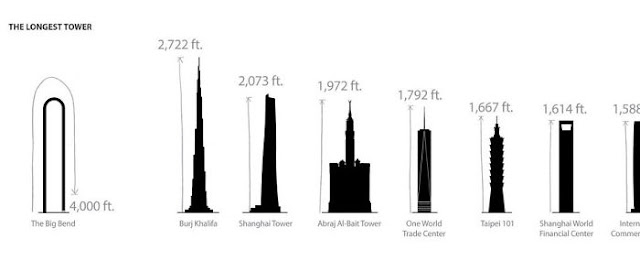That really is a high rise? A New
York architecture firm has unveiled designs for a skyscraper that is out of
this world and imaginations. Deemed the “World’s tallest building ever”,
Analemma Tower will be suspended from an orbiting asteroid 31,068 miles above
the Earth & the only way to leave is by parachute. The orbital path would
swing the tower in a figure eight pattern between the northern and southern
hemispheres each day, taking residents on a tour through different parts of the
world all in just a 24 hour orbital cycle. Therefore, the radical design was
created by Clouds Architecture Office, which is also the mastermind behind proposals
for a Mars house and a cloud city. The latest design Tower, will 'overturn the
established skyscraper typology', as it builds from the sky down, instead of
the ground up.
The company explains, through the
course of history humanity has been able to affect the environment on
increasing scales, hence massive skyscraper will be setup in sections and each
with a designated purpose. However, business will be conducted at the lower end
of the towers and sleeping quarters will be positioned two-thirds of the way up
the building. Moreover, inhabitants will also have access to a gardening area,
a place for worship and in the bottom level will be sections for dining,
shopping and entertainment. The architects plan to take full advantage of the
skyscraper's location and will place solar panels at the upper most levels to
generate power from the sun. Further, inhabitants will relish fresh water from
condensation of clouds and rainwater, which will be collected & purified. Nowadays
our activity is being registered on a global scale. So why not apply design
thinking on a planetary scale? Analemma Tower will be an example of a mixed use
building that incorporates planetary design strategies, yielding the world’s
tallest building ever. It seems that architect is not just developing a massive
skyscraper, but is also designing a floating city. It will be setup into
sections, each with a designated purpose. The architect firm plans to design
shape-shifting windows that change size and height in order to deal with
pressure and temperature differentials.
The design will use a system
called the Universal Orbital Support System (UOSS), which attaches a high
strength cable to an asteroid that is lowered to Earth and then attached to the
tower. Since this new tower typology is suspended in the air, it can be
constructed anywhere in the world and transported to its final location. The
proposal calls for Analemma to be constructed over Dubai, which has proven to
be a specialist in tall building construction at one fifth the cost of New York
City construction. Clouds Architecture Office shared on its website. Though
some may question the firm’s ability to capture an asteroid for the project,
Clouds Architecture Office believes its idea will soon no longer be just a
concept from science fiction films.
In 2015 the European Space Agency
flashed a new round of investment in asteroid mining concerns by proving with
its Rosetta mission that it's likely to rendezvous and land on a spinning
comet, shared the firm. Furthermore, NASA has scheduled an asteroid retrieval
mission for 2021 which aims to show the feasibility of capturing and relocating
an asteroid. The tower would travel on a figure 8th path over certain major
cities in the northern and southern hemispheres, includes New York City,
Havana, Atlanta and Panama City. Therefore, the amount of daylight increases by
40 to 45 minutes at the top of the tower due to the curvature of the Earth. Analemma
can be placed in a peculiar geosynchronous orbit which would let it to travel
between the northern and southern hemispheres on a daily loop,’ Clouds
Architecture Office explained. The ground trace for this pendulum tower would
be a figure eight, where the tower would move at its sluggish speed at the top
and bottom of the figure eight letting the possibility for the towers occupants
to interface with the planet’s surface at these points. The proposed orbit is
calibrated so the gentlest part of the towers trajectory occurs over New York
City.’ However, while studying atmospheric conditions for the project, the team
discovered that there is most likely a height that people could not bear due to
the extreme conditions. For example, though there may be a benefit to having 45
extra minutes of daylight at an elevation of 32,000 meters, the close vacuum
and -40C temperature would prevent people from going outside without a
protective suit,’ shared Clouds Architecture Office. Then again, astronauts
have continually occupied the space station for decades, so perhaps it’s not so
bad?




















































